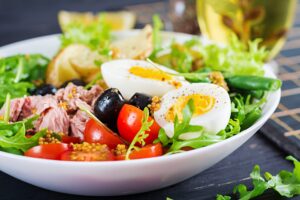Are you looking to shed those extra pounds and achieve your weight loss goals? Look no further! The ultimate guide to the keto diet for weight loss is here to help you on your journey toward a healthier and happier you.
This comprehensive guide will provide you with all the information you need to understand the science behind the keto diet, get started with the basics, create a meal plan for optimal weight loss, navigate challenges, overcome plateaus, and maintain long-term success.
In this guide, you will discover the science behind the keto diet and how it can help you achieve your weight loss goals. You will learn about the process of ketosis, where your body switches from using glucose as its primary fuel source to burning fat for energy. By understanding the science behind the diet, you will be able to make informed decisions and stay motivated throughout your weight loss journey.
Getting started with the keto diet may seem overwhelming at first, but fear not! This guide will break down the basics for you in a simple and easy-to-understand way. You will learn about the types of food you should be eating, as well as those you should avoid.
With a clear understanding of what to eat and what to avoid, you will be able to create a meal plan that suits your taste and helps you achieve your weight loss goals.
So, are you ready to embark on this exciting journey towards a healthier and fitter you? Let’s dive in and get started on your ultimate guide to the keto diet for weight loss!
Key Takeaways
- Reduce carbs and increase healthy fats to get started with the keto diet.
- Create a meal plan that includes variety and plan ahead for optimal weight loss.
- Mix up routines and focus on non-scale victories to overcome challenges and plateaus.
- Find delicious and satisfying recipes to maintain long-term success with the keto diet.
Understanding the Science Behind the Keto Diet
Now that you understand the basics of the keto diet, let’s dive deeper into the science behind it and how it can lead to weight loss for you.
The keto diet is based on the principle of ketosis, which is a metabolic state where your body switches from using carbohydrates as its primary source of fuel to using fat. When you consume a high amount of fat and restrict your intake of carbohydrates, your body starts breaking down fat into molecules called ketones, which can then be used as fuel by your brain and muscles. This shift in fuel source can have a profound impact on your weight loss journey.
By following a keto diet, you are essentially training your body to become more efficient at burning fat for fuel. When your body is in a state of ketosis, it can tap into its fat stores and use them as a constant source of energy. This means that even when you’re not actively exercising, your body is still burning fat.
Additionally, the keto diet can help regulate your appetite and cravings. When you consume a high amount of carbohydrates, your blood sugar levels spike, leading to a rapid increase in insulin production. This can result in cravings and overeating. However, on the keto diet, your blood sugar levels remain stable, which can help reduce cravings and promote weight loss.
Understanding the science behind the keto diet can empower you to make informed decisions about your weight loss journey. By following a keto diet, you can train your body to become a fat-burning machine and regulate your appetite and cravings.
So, if you’re ready to take control of your health and achieve your weight loss goals, the keto diet may be the perfect fit for you.
Getting Started: The Basics of the Keto Diet
Starting out on the keto diet can seem intimidating, but don’t worry, it’s easier than you think! The basics of the keto diet involve reducing your carbohydrate intake and increasing your consumption of healthy fats.
By doing this, your body enters a state called ketosis, where it starts using fat as its primary source of fuel instead of carbohydrates. This shift in fuel source can lead to rapid weight loss and increased energy levels.
To get started on the keto diet, the first step is to eliminate or greatly reduce your intake of foods high in carbohydrates such as bread, pasta, rice, and sugary snacks. Instead, focus on incorporating foods that are high in healthy fats like avocados, nuts, and olive oil.
It’s also important to include a moderate amount of protein in your diet, which can be found in foods like eggs, fish, and poultry.
In addition to adjusting your diet, it’s also recommended to drink plenty of water and engage in regular exercise to maximize the benefits of the keto diet.
It may take some time for your body to fully adjust to the new way of eating, but with dedication and a positive mindset, you can achieve your weight loss goals. So, don’t be afraid to give the keto diet a try and embark on a journey towards a healthier and happier you!
Creating a Meal Plan for Optimal Weight Loss
To create a meal plan that maximizes your weight loss potential, envision a week filled with delicious, low-carb meals that keep you satisfied and energized. Here’s a guide to help you create a meal plan that not only supports your weight loss goals but also keeps you motivated and excited about your keto journey.
- Variety is key: Incorporate a wide range of vegetables, proteins, and healthy fats into your meal plan. This not only ensures you get all the essential nutrients your body needs but also keeps your taste buds happy. Experiment with different vegetables and proteins to keep your meals interesting and enjoyable.
- Plan: Take some time each week to plan your meals. This not only helps you stay organized but also prevents last-minute unhealthy food choices. Plan your meals around your schedule and make sure you have all the ingredients you need on hand. This way, you can stick to your keto diet without any obstacles.
- Keep it simple: Don’t overcomplicate your meal plan with complicated recipes or hard-to-find ingredients. Stick to simple, easy-to-make meals that you enjoy. This will make it easier for you to stick to your plan and avoid any feelings of deprivation or restriction.
- Listen to your body: Pay attention to how your body feels after each meal. Notice how certain foods make you feel energized and satisfied, while others may leave you feeling sluggish or bloated. Use this feedback to adjust your meal plan accordingly, ensuring that you are nourishing your body with foods that truly serve you.
Navigating Challenges and Overcoming Plateaus
Overcoming plateaus on the keto diet is like finding a hidden path through a dense forest, requiring persistence and creative strategies. It can be frustrating when you hit a weight loss plateau, but don’t forget that it’s just a temporary setback on your journey to a healthier you.
The key is to stay motivated and keep pushing forward.
One of the most effective ways to overcome a plateau is to mix up your routine. Your body can get used to the same foods and exercises, so try incorporating new recipes and workouts into your keto diet plan. Experiment with different types of low-carb vegetables, proteins, and fats to keep things interesting and prevent boredom.
Additionally, try adding some high-intensity interval training (HIIT) or strength training exercises to your fitness routine. These types of workouts can help kickstart your metabolism and break through the plateau.
Another strategy to overcome plateaus is to focus on non-scale victories. Instead of solely relying on the number on the scale, pay attention to other positive changes in your body and overall well-being. Take note of how your clothes fit, your increased energy levels, and any improvements in your mental clarity and focus. Celebrate these wins and use them as motivation to keep going.
You’re on a journey to better health, and with determination and creative strategies, you can overcome any obstacle that comes your way. Keep serving yourself by taking care of your body and mind, and success will come.
Maintaining Long-Term Success on the Keto Diet
Maintaining long-term success on the keto diet is all about finding delicious and satisfying recipes that keep you motivated and enjoying the journey. It’s important to keep your meals interesting and varied, so you don’t get bored and tempted to stray from your diet. Luckily, there are plenty of tasty options that are keto-friendly. Here are a few ideas to help you stay on track:
| Breakfast | Lunch | Dinner | Snack |
|---|---|---|---|
| Avocado and eggs | Chicken salad lettuce wraps | Grilled salmon with asparagus | Cheese and nut plate |
| Bacon and eggs | Turkey lettuce wraps | Steak with cauliflower mash | Guacamole with cucumber |
| Spinach and feta omelette | Tuna salad stuffed avocado | Lemon herb chicken with broccoli | Celery sticks with almond butter |
In addition to delicious recipes, it’s important to have a support system in place to help you stay motivated and accountable. Find a friend or family member who is also following the keto diet, and commit to checking in with each other regularly. Share your successes and challenges, and offer each other encouragement along the way. You can also join online forums or social media groups dedicated to the keto diet, where you can connect with like-minded individuals and get inspiration and tips.
Frequently Asked Questions
Can the keto diet be followed by vegetarians or vegans?
Yes, the keto diet can be followed by vegetarians or vegans. While it may seem challenging at first, there are plenty of plant-based protein sources and low-carb vegetables that can be incorporated into your meals.
Is it safe to follow the keto diet while pregnant or breastfeeding?
While following the keto diet during pregnancy or breastfeeding may seem tempting, it’s crucial to prioritize the health of both you and your baby. Consult with your healthcare provider to ensure a safe and balanced approach.
How long does it take to enter ketosis and start experiencing weight loss?
On average, it takes about 2-4 days to enter ketosis and start experiencing weight loss on the keto diet. But here’s an interesting fact: did you know that some people can enter ketosis in just 24 hours? Incredible, right?
Can I consume alcohol while following the keto diet?
Yes, you can consume alcohol while following the keto diet, but choose wisely. Stick to low-carb options like vodka, gin, or tequila, and avoid sugary mixers. Don’t forget to drink in moderation and be mindful of your overall carb intake.
Is there any scientific evidence supporting the long-term safety and effectiveness of the keto diet?
You may be wondering if the keto diet is safe and effective in the long run. Well, fear not! Scientific evidence has shown that the keto diet can indeed be a reliable and successful method for weight loss.














